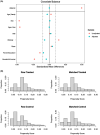Callous-unemotional traits, cognitive functioning, and externalizing problems in a propensity-matched sample from the ABCD study
- PMID: 39496559
- PMCID: PMC11812496
- DOI: 10.1111/jcpp.14062
Callous-unemotional traits, cognitive functioning, and externalizing problems in a propensity-matched sample from the ABCD study
Abstract
Background: Many studies show that both callous-unemotional (CU) traits (e.g., low empathy, lack of guilt) and cognitive difficulties increase risk for externalizing psychopathology across development. However, other work suggests that some aggression (e.g., relational, proactive) may rely on intact cognitive function, which could vary based on the presence of CU traits. Moreover, no prior research has adequately accounted for common risk factors shared by CU traits, cognitive difficulties, and externalizing problems, which confounds conclusions that can be drawn about their purported relationships. The current study addressed these knowledge gaps by leveraging rigorous propensity matching methods to isolate associations between CU traits and different dimensions of cognitive function and externalizing problems.
Methods: Associations between CU traits, cognitive functioning, and externalizing outcomes were tested within dimensional (n = 11,868) and propensity-matched group-based (n = 1,224) models using data from the Adolescent Brain Cognitive Development Study®, with rigorous statistical control for shared sociodemographic risk factors. Cross-sectional outcomes were parent-reported symptoms of conduct disorder (CD), oppositional defiant disorder (ODD), and attention deficit hyperactivity disorder (ADHD). Longitudinal outcomes were child-reported overt and relational aggression.
Results: CU traits were uniquely related to more parent-reported CD, ODD, ADHD symptoms, as well as more child-reported aggressive behaviors. Effects of cognitive difficulties were domain specific and were not consistent across dimensional and propensity matched models. There was minimal evidence for divergent associations between CU traits and externalizing outcomes as a function of cognition (i.e., no moderation).
Conclusions: Rigorous control for sociodemographic factors within propensity-matched models establish CU traits as a robust and unique risk factor for externalizing psychopathology, over and above difficulties with cognitive functioning.
Keywords: aggressive behavior; callous‐unemotional traits; cognitive function; externalizing disorders.
© 2024 The Author(s). Journal of Child Psychology and Psychiatry published by John Wiley & Sons Ltd on behalf of Association for Child and Adolescent Mental Health.
Figures





Similar articles
-
Callous-unemotional traits, proactive aggression, and treatment outcomes of aggressive children with attention-deficit/hyperactivity disorder.J Am Acad Child Adolesc Psychiatry. 2013 Dec;52(12):1281-93. doi: 10.1016/j.jaac.2013.08.024. Epub 2013 Sep 25. J Am Acad Child Adolesc Psychiatry. 2013. PMID: 24290461 Free PMC article. Clinical Trial.
-
Unique versus shared neural correlates of externalizing psychopathology in late childhood.J Psychopathol Clin Sci. 2024 Aug;133(6):477-488. doi: 10.1037/abn0000923. Epub 2024 Jun 13. J Psychopathol Clin Sci. 2024. PMID: 38869879 Free PMC article.
-
Callous-unemotional traits moderate the association between inhibitory control and disruptive behavior problems.Eur Child Adolesc Psychiatry. 2025 May;34(5):1545-1555. doi: 10.1007/s00787-024-02582-9. Epub 2024 Sep 14. Eur Child Adolesc Psychiatry. 2025. PMID: 39276248
-
Association between callous unemotional traits cognitive control performance and reward sensitivity in youths with conduct problems - A systematic review and meta-analysis.Neurosci Biobehav Rev. 2025 Jul;174:106211. doi: 10.1016/j.neubiorev.2025.106211. Epub 2025 May 12. Neurosci Biobehav Rev. 2025. PMID: 40368262 Review.
-
The Irritable and Oppositional Dimensions of Oppositional Defiant Disorder: Integral Factors in the Explanation of Affective and Behavioral Psychopathology.Child Adolesc Psychiatr Clin N Am. 2021 Jul;30(3):637-647. doi: 10.1016/j.chc.2021.04.012. Child Adolesc Psychiatr Clin N Am. 2021. PMID: 34053691 Review.
References
-
- Achenbach, T.M. , & Ruffle, T.M. (2000). The Child Behavior Checklist and related forms for assessing behavioral/emotional problems and competencies. Pediatrics in Review, 21, 265–271. - PubMed
-
- Barch, D.M. , Albaugh, M.D. , Avenevoli, S. , Chang, L. , Clark, D.B. , Glantz, M.D. , … & Sher, K.J. (2018). Demographic, physical and mental health assessments in the adolescent brain and cognitive development study: Rationale and description. Developmental Cognitive Neuroscience, 32, 55–66. - PMC - PubMed
-
- Baskin‐Sommers, A.R. , Waller, R. , Fish, A.M. , & Hyde, L.W. (2015). Callous‐unemotional traits trajectories interact with earlier conduct problems and executive control to predict violence and substance use among high risk male adolescents. Journal of Abnormal Child Psychology, 43, 1529–1541. - PubMed
MeSH terms
Grants and funding
LinkOut - more resources
Full Text Sources

